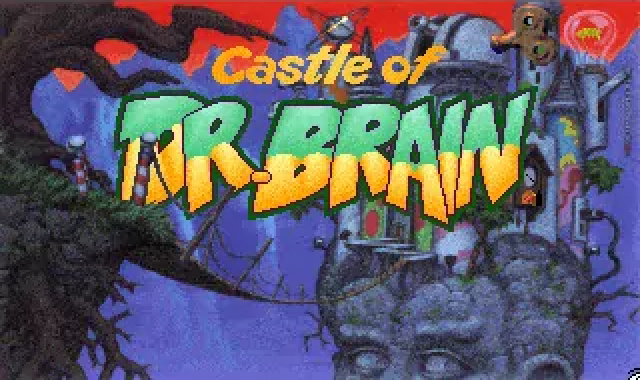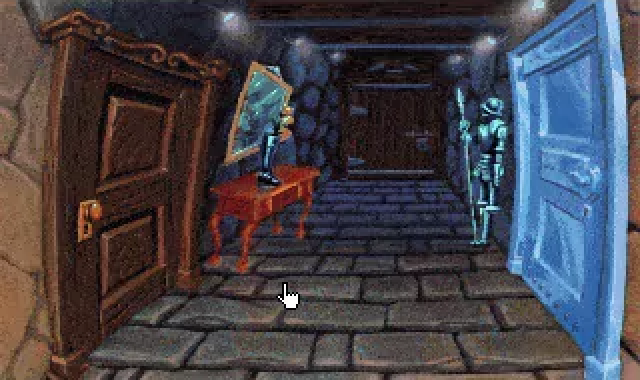In 1992, Sierra On-line was at the top of their game. They had multiple Quest titles, the 3.5 floppy infrastructure let them make a lot of experimental games without incurring the same kind of heavy costs as would eventually bury the company in the CD and internet era. Part of this was because they had, on deck Corey and Lori Ann Cole, the people who made my favourite Sierra games, the Quest For Glory series, with the point-and-click VGA engine. Know what happens when you get cool people who can use interesting tools in a low-cost low-risk environment?
They screw around and make cool shit!
The Castle of Dr Brain is a educational game from the same people who were selling Leisure Suit Larry V – Passionate Patti Does A Little Undercover Work, aimed at a kid audience that reached from say eight years old to ‘until the kid is too bored to deal with this shit’ years old. The idea is that there’s this whacky scientist with an odd sense of humour, Dr Brain (I mean with that surname, obviously you would right), who is looking to hire an assistant. You want to get the job, so you show up at his place and… that’s it, that’s your lot, you want to go inside and meet him for the appointment.
What ensues is the classic gameplay model of being kicked down the puzzle stairs, bouncing off different puzzles as you go, with some genuinely cute ideas mixed in to a series of different kinds of puzzles. And I mean there’s a lot – there are programming puzzles, math puzzles (though aren’t all puzzles math puzzles, in a way), mazes (augh), an actual jigsaw, programming puzzles and even some low-key trivia information (like, the order of the planets). There’s a hint coin system so you don’t get too lost (which kinda doesn’t work), and the puzzles keep mixing up so you don’t have to do too many of the same kind of puzzles at the same time.
There’s a bunch of games like this from around this period of Sierra’s development. Part of it was a technological shift. Storage was getting easier, and background art had been ‘recently’ made ‘easier.’ I mean ‘recently’ in that it was the previous year or so, but also ‘easier’ in that now Sierra could hire people to paint background graphics with actual paints and then scan them in, which is how Sierra’s background art in this period is always really beautiful for 320×240 graphics. There were even attempts to make online multiplayer games, starting with ambitious ideas like Leisure Suit Larry 4, which was going to be a narrative adventure game where you could play with other people doing the same adventure at the same time.
They’re very ‘proof of concept’ – like if you want, you can play Backgammon against King Graham from Kings Quest (and you shouldn’t, because death to kings). Sierra has all these small games like Hoyle’s House Of Games and Quirky and Quaysoo’s Turbo Science, and you can go check if I got those right from memories.
Thing is, most of those were just ‘hey, can we do checkers or hangman or a magic square puzzle,’ whereas The Castle of Dr Brain attempted to explain these puzzles in some kind of narrative. Obviously if you can make twenty different kind of abstract puzzles with only the faintest of themes, you have to string them together in some way, and it amuses me greatly that the solution in this game was ‘well, what if you were in the house of some dork who just set up a bunch of puzzles?’
What’s really interesting about this game, and a reason to check it out now, is because of how it has to try and communicate the interface of its puzzles to an audience that may be encountering them for the first time. There’s a way to explain them – you can press the ? button to get a text explanation for each game – but that explanation is a little inadequate.
The game is deliberately and proactively introducing you to different things where you get to press the buttons to see how they work to try and make the game explain itself. The puzzles are designed so that they can’t be completely broken, and can always be reset in some way. They are designed so that there’s no ‘real time’ elements – every puzzle is turn based, meaning that they behave in response to your agency.
This is an example of the boundaries on your affordance. When you present players with a button, that button needs to be explained, and you can design the buttons so they explain themselves based on what they’re related to. What’s more, you can design an interface so if you just dick around with it, it’ll explain itself through how they safely relate to one another.
You can go get The Castle of Dr Brain, if you want – it’s abandonware and runs just fine under Dosbox.


